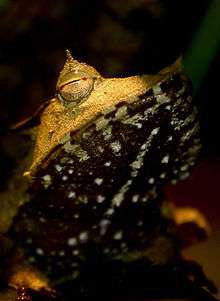Hemiphractus
| Hemiphractus | |
|---|---|
 | |
| Hemiphractus fasciatus | |
| Scientific classification | |
| Kingdom: | Animalia |
| Phylum: | Chordata |
| Class: | Amphibia |
| Order: | Anura |
| Family: | Hemiphractidae |
| Genus: | Hemiphractus Wagler, 1828 |
| Diversity | |
| 6 species (see text) | |
| Synonyms | |
|
Cerathyla Jiménez de la Espada, 1870 | |
Hemiphractus (known as horned (tree)frogs) is a genus of frogs in the family Hemiphractidae.[1][2] They are found in northern South America and Panama.[1]
Description
Hemiphractus are robust-bodied frogs.[3] The genus is characterized by a fleshy proboscis on terminus of snout and fleshy tubercles on eyelids, skull that is highly casqued with prominent lateral occipital processes projecting backwards, and fang-like maxillary and premaxillary teeth.[4]
Female frogs carry eggs openly on their back; the eggs adhere to the mother's back with gelatinous material. Eggs hatch as fully developed froglets.[5]
Ecology and behaviour
Hemiphractus are believed to be specialized predators of other frogs, and hence confined to areas with high density of frogs.[6] They can threat their predators by opening their mouth, exposing the colourful tongue.[7]
Species
There are six recognized species:[1]
- Hemiphractus bubalus (Jiménez de la Espada, 1871)
- Hemiphractus fasciatus Peters, 1862
- Hemiphractus helioi Sheil & Mendelson, 2001
- Hemiphractus johnsoni (Noble, 1917)
- Hemiphractus proboscideus (Jiménez de la Espada, 1871)
- Hemiphractus scutatus (Spix, 1824)
References
- 1 2 3 Frost, Darrel R. (2015). "Hemiphractus Wagler, 1828". Amphibian Species of the World: an Online Reference. Version 6.0. American Museum of Natural History. Retrieved 7 August 2015.
- ↑ "Hemiphractidae". AmphibiaWeb: Information on amphibian biology and conservation. [web application]. Berkeley, California: AmphibiaWeb. 2015. Retrieved 7 August 2015.
- ↑ Vitt, Laurie J.; Caldwell, Janalee P. (2014). Herpetology: An Introductory Biology of Amphibians and Reptiles (4th ed.). Academic Press. p. 497.
- ↑ Sheil, C. A.; Mendelson III, J. R. (2001). "A new species of Hemiphractus (Anura: Hylidae: Hemiphractinae), and a redescription of H. johnsoni.". Herpetologica. 57: 189–202. JSTOR 3893183.
- ↑ Vitt and Caldwell (2014), p. 166, 497
- ↑ IUCN. "IUCN Red List of Threatened Species. Version 2015.2. <www.iucnredlist.org>". Retrieved 12 August 2015.
- ↑ Vitt and Caldwell (2014), p. 322